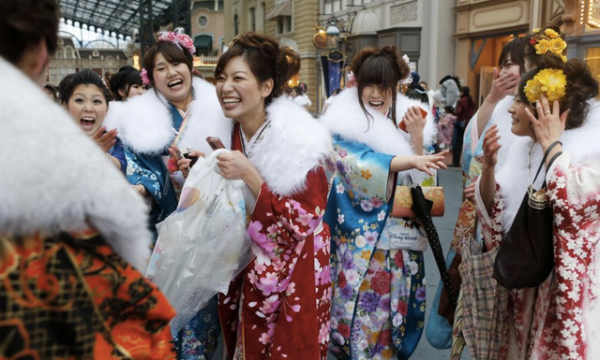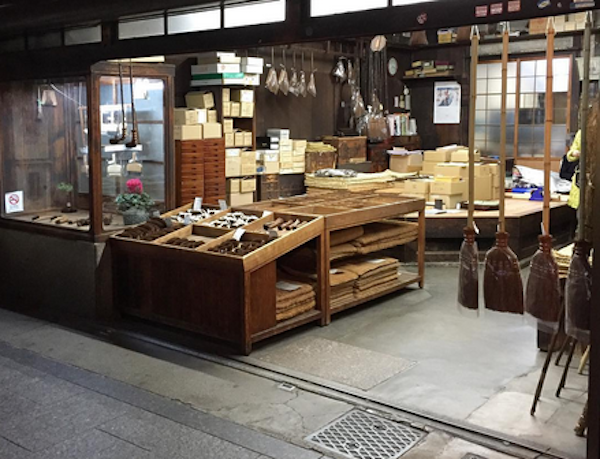Our three weeks in Japan went quickly, and while we were able to visit six major cities, it would take a person several months to fully explore this unique country. We're glad we saved it for the last stop on our traverse through Asian so we could compare Japan’s distinctive culture to those of the other eight countries we visited. For one thing, starting in 1637 they purposely isolated themselves from the outside world for nearly 300 years - plenty of time for some of the major quirks to take hold!
We loved the way the past rubbed up like a cat against the present. The way that ceremony held sway in personal interactions from bowing, to the two-handed passing of business cards (or anything else) to the elaborate pouring of tea. While at the same time, blazing neon, blaring music, anime, animal-petting cafes, Pachinko palaces, and purveyors of plastic had their own space. The one constant seemed to be food - there are trends of course, but ancient recipes and traditional presentations smoothed any cultural bumps in the road so that goth-geishas and buttoned-up business moguls could sit side-by-side at a Ramen bar in slurping harmony.
If you read the previous blog, you know we experienced the June 18th, 6.1 earthquake in Osaka. We were 35 miles away in Kyoto, but we felt every shudder and shake. It was also the day we were set to move to Hiroshima, but those plans were demolished. We gladly spent an additional night safely in Kyoto as guests of our Airbnb host at no charge.
The next morning, the trains from Kyoto’s main station were running on schedule so we set off. We’d lost a day in Hiroshima, so once we arrived and finally found our minuscule Airbnb, we tossed our bags inside and headed directly to the Hiroshima Peace Memorial and Museum. The skies were gray and there was a steady drizzle of rain - weather befitting the occasion.
Over one million paper "peace cranes" fill these cases. They come from children and organizations around the world inspired by a young girl named Sadako Sasaki who died of radiation induced leukemia in 1955 at the age of 10.
The museum was well designed and certainly thought-provoking. Like any war memorial it is a place that should be visited, no matter how difficult, as a reminder of the devastation of war. The personal stories were incredibly moving and brought a reality to something so hard to conceive. And the scientific facts laid out in the museum clearly demonstrated that even more devastating destruction lies ahead if nuclear weapons are ever deployed again.
Afterward, we found an Indian restaurant in a bustling mall that served a simple, but delicious dinner - it was a nice change in cuisine. When we got back to our flat we laid out the two single futons (the only furniture in the main room) on the tatami mats and turned on the tiny TV to watch Japan beat Columbia 3-1 in a World Cup match laying flat on our backs. Maybe we should have found a Sake bar.
We moved on from Hiroshima for a two-night stay in Fukuoka, a city recommended by more than one friend. At the train station we flashed our Japan Rail Passes like pros and scooped up a bag of tiny caramelized croissants for a travel snack. If I could have turned the train around for more, I would have. I was convinced at that point that every morsel of food created in Japan is meant to be perfect, no matter how humble.
We will need way more that two of those Mr. Campbell!
Speaking of food perfection. I was fascinated by the fake food in so many restaurants. Here's a short Youtube video on how it's made! And here's one that goes into more in-depth.
Our Airbnb was a decent size and nicely decorated, and even had a queen-size bed! And the location was great for exploring both the old parts of town and the glitzy shopping centers. We wandered the city and eventually ended up on the top floor of the largest mall in “Ramen World”, a foodcourt supported by the Japanese Ministry of Culture where several of Japans top Ramen Houses have pop-up restaurants.
On our second day, we took a day trip to the coast to visit the Uminonakamichi Gardens. It took two trains (one fast and one slowpoke local line) to get there, but it was worth the journey. There was a magnificent hydrangea grotto where a dozen varieties nodded their blooms in the breeze. There were pathways through the gardens and bike trails along a cliff above the water and in the center a small zoo with a unique collection of species - including a huge flock of shocking pink Flamingos.
It was time to return to Kyoto for our second week and a new Airbnb. This time we were in a Ryokan style house. It was nice to be at ground level with a front door and two bikes parked outside for our use. Of all of our stays, this place really felt like we were living locally in a home of our own. We had a choice between sleeping on futons or using a trundle bed in the kitchen. We opted for the bed and felt like two ten-year-olds at a slumber party. The bathroom was fitted with a deep soaking tub that auto-filled to the exact level and temp of your choice - and of course, the ultimate toilet. I want this exact bathroom wherever we finally set up house.
Our host and her son met us at the door. Miyuki was the sweetest woman, and she was absolutely committed to our comfort and making sure we made the most of our time in Kyoto. She had lists of things we should do and see, and even gave us tickets to visit her favorite garden and shrine in the Gion district.
We were a little further away from the train station this time - a solid 1/2 hour walk, but there was a mall halfway with a great supermarket and huge Muji and Uniqlo stores. Often that was far enough for me!
When we were here a few weeks earlier, Michael took a walking tour of the Gion District, famous for its Geisha culture and teahouses, while I spent the day writing. In the meantime, we both finished rereading Memoirs of a Geisha (for a second time) so we went back and walked the streets with a new perspective.
I also sought out Naito Rikimatsu Shoten, a hole-in-the-wall shop that has been making household brushes by hand for generations. I was looking for a small, angled Shuro brush for our son-in-law that would be perfect for dusting wood shavings out of tight corners in his workshop.
Our day trips included the beautiful city of Nara and it’s famous park where herds of tame deer roam the grounds. They come right up to you and nuzzle your pockets looking for the oat biscuits you can buy from vendors.
Another day began with a trip to the bamboo forest in Arashiyama. It was a beautiful day to visit, but we wondered how this patch of bamboo became such a highly rated attraction. There were hundreds of people crowding the narrow paths and the tourist shops were overwhelming. We got our Zen back later in the day at the Ryosokiun Temple and gardens in Gion where our host had given us entrance tickets. If you book ahead you can take an hour-long initiation to Zazen meditation here, which seems like a very special opportunity.
Our day trip to Osaka included a long walking tour with time spent in the famous market. There was some damage from the earthquake here and there, but nothing that slowed the pace of this huge city. "Eat Street" was bustling with those in search of an easy lunch of sushi or grilled skewers of just about anything, but there was always a line for places that served Osaka's famous Takoyaki - small batter-balls with a succulent piece of octopus tucked inside. A small paper boatfull drizzled with "secret sauce" and a dusting of bonito flakes made a delicious, walkable snack.
It’s always helpful when we make the effort to learn a few basic words of a language to show we have some manners! We liberally used the common greeting of konnichiwa delivered with a slight bow, Onegai-shimasu and Arigato for please and thank you. And of course, we all know to offer sayonara on our way out the door.
I particularly love the Japanese variations of Yes and No. “Hai” means yes, and it was said from the back of the throat with a sharp emphasis on the H so it sounded like a hack. "Lie" means no and often that comes with both arms crossed in an X across the chest. It seemed aggressive at first, but it’s no more menacing than the emphatic head shake that comes with “no way!”
We were glad we saved this magical, mystical, cultural mash-up of a country for last!
Starting with Singapore and ending with Japan we visited nine Asian countries in just under three months. That was a lot to take in. So when I write these blogs, it gives me the opportunity to stop and reflect on each unique country and it's culture. Thanks for joining me as I have tripped down memory lane, I've appreciated your company.
Thanks for following along,
Debbie and Michael Campbell
The Senior Nomads














